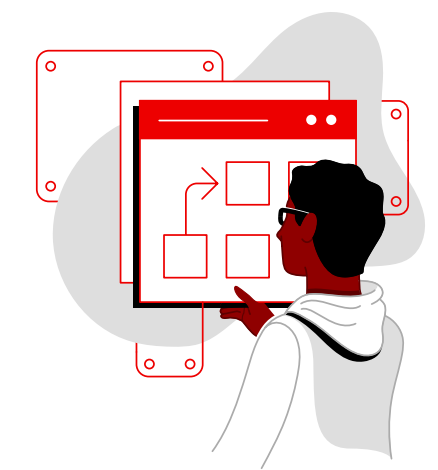Automate Red Hat Enterprise Linux
Introduction
Red Hat® Enterprise Linux® is an essential foundation for a stable, reliable, and consistent IT environment across datacenters, clouds, and at the network edge.
However, managing a platform as flexible as Red Hat Enterprise Linux while also maintaining complex, heterogenous systems and applications is increasingly time-consuming and error-prone. This can result in inefficient IT operations, performance issues, or security risks when vulnerabilities aren’t addressed in a timely manner.
Inconsistent configuration across users, applications, and environments can create long-term maintenance issues. Busy IT teams struggle to keep up with the complexity while organizations contend with skill gaps among users. Plus, proprietary knowledge often rests in the hands of a few individuals, leaving the day-to-day management of systems and infrastructure at risk if those individuals leave the organization.
Understand the impact of automation for Red Hat Enterprise Linux
An overview of the Red Hat Enterprise Linux deployment process with Red Hat Ansible® Automation Platform:
Day 0
The design or planning phase of a Red Hat Enterprise Linux deployment. This is when organizations determine the requirements to get systems up and running while ensuring availability and reliability throughout the migration or deployment process.
Day 1: Infrastructure as Code
Infrastructure as Code (IaC) is the managing and provisioning of infrastructure through code instead of through manual processes. The initial provisioning, configuration, and deployment of Red Hat Enterprise Linux happens at this stage. With automation, Day 1 tasks become simplified and accelerated through Infrastructure as Code (IaC).
Day 2: Operations as Code
Operations as Code (OaC) is when organizations use automation to resolve ongoing repetitive IT tasks such as patching, backups, reboots, and security fixes to keep Red Hat Enterprise Linux systems running smoothly. In more advanced applications, organizations can adopt event-driven automation to proactively remediate these issues as soon as they are detected by observability platforms or other systems.
In this e-book we will show how Red Hat Ansible Automation Platform can help simplify the deployment and management of Red Hat Enterprise Linux along with other applications and platforms across diverse IT environments. We'll provide insight into the features and capabilities that support your automation journey from IaC to OaC and beyond.
OaC is where your automation investment begins to deliver tangible, long-term technical and business benefits.
Chapter 1: The value of automating Red Hat Enterprise Linux
Automation is no longer considered just another tool, nor is it seen as a threat to IT professionals' livelihoods. It has become mission-critical for IT organizations wanting to optimize performance, agility, speed, and security. In short, automation is no longer simply a “nice to have" element of any effective modern IT strategy, but a necessity.
With a flexible, modern automation platform, you can:
Ensure consistency at scale
Use shareable, repeatable templates to establish a common, stable, and predictable path to managing Red Hat Enterprise Linux across any environment. This standardization is especially important as your organization transitions from operating only on-premise systems to more complex hybrid and multicloud environments.
Reduce security and compliance risks
Since automation establishes standardized workflows, provisioning and configuration happen the same way every time and eliminate “snowflake” systems that may require specialized expertise to run. This not only reduces human error in the execution of operational tasks, but helps teams adhere to a reliable schedule.
Accelerate time to market
Applications and services can be brought to market more quickly, accelerating time to value for your customers. This means an IT organization has fewer periods of burn (where resources are spent, but money isn’t coming in) and helps establish a more predictable revenue stream for the business.
Increase IT team productivity and efficiency
Automation reduces the need for manual, repetitive, lowervalue tasks such as resolving security and performance issues and applying patches. By easing the burdens of root cause analysis and investigation, IT teams are able to focus on higher value tasks that are more professionally rewarding. Systems run more reliably, even at the edge, so 24x7 operations can be more predictable. Businesses benefit from greater efficiency, agility, innovation, and strategy.
Eliminate cross-functional barriers and build skills
Consolidating disparate automation tools and adopting a single platform helps teams align on common terminology, framework, and best practices, allowing IT professionals to share ideas and learn from their peers.
8 months to payback on investment on average with Ansible Automation Platform.¹
Alstom uses Red Hat technologies to accelerate application modernization and management while delivering new business innovation
By implementing and standardizing on Red Hat Enterprise Linux as its host operating system on bare metal, Alstom was able to transform its railway Internet of Things (IoT) devices to a flexible and more modern solution for data acquisition and edge processing. This containerized architecture means Alstom is now able to more securely, reliably, and easily deploy edge applications. The addition of Ansible Automation Platform has allowed Alstom to reduce manual processes by automating the lifecycle of edge devices—from management to patching to new application deployment—with updates delivered to fielded devices in real-time or on demand.
36% higher development team productivity with Ansible Automation Platform.¹
Chapter 2: Inside Ansible Automation Platform for Red Hat Enterprise Linux
Overview
Red Hat Ansible Automation Platform is a leader in infrastructure automation, according to the Forrester Wave,² that includes everything needed to build, deploy, and manage end-to-end automation on Red Hat Enterprise Linux at scale.
Ansible Automation Platform helps enterprises with complex, heterogeneous environments create and execute repeatable workflows that include Red Hat Enterprise Linux, along with other operating systems such as Microsoft Windows, storage systems, IT Service Management (ITSM) platforms, networking devices, security systems, and much more.
With Ansible Automation Platform, you can reduce operational bottlenecks and points of failure, consolidate ad hoc and disparate automation tools, adopt a culture of collaboration, improve IT operations, and make time for innovation.
Built on a powerful, agentless framework, Ansible Automation Platform helps you create, manage, and scale automation across your organization.
Create
Ansible Content Collections provide trusted, expert-generated code to help you start automating right away. They include both Red Hat Ansible Certified Content and Ansible validated content for integration with Red Hat platforms and solutions from over 70 industry-leading partners.
Red Hat Ansible Lightspeed with IBM watsonx Code Assistant is a generative AI service that helps Red Hat Enterprise Linux system administrators and developers with diverse skills and experience learn to create and maintain Ansible Automation Platform content more efficiently.
Ansible development tools help system administrators and developers create, test, and deploy reliable code. This suite of tools accelerates Ansible content development cycles and helps organizations improve time to value.
Automation execution environments are container images used to execute Ansible Playbooks and roles consistently across diverse Red Hat Enterprise Linux deployments, whether in a datacenter, cloud, or at the network edge.
Ansible automation hub is a catalog used to find, download, and share content collections for Red Hat Enterprise Linux System Roles as well as other industry solutions. Private automation hub lets you create your own curated library of automation content for internal teams to use and share.
Red Hat Enterprise Linux System Roles
Red Hat Enterprise Linux System Roles are an example of Red Hat Ansible Certified Content that can be scheduled and executed at scale through Ansible Automation Platform. They support automation for provisioning, configuration, and patching that is shareable and trusted for enterprise operations.
Manage
Automation controller is a centralized management tool to manage inventory, launch and schedule Red Hat Enterprise Linux workflows, track changes, and integrate reporting with a centralized user interface.
Automation analytics and Red Hat Insights provide rich reporting and advanced analytics to optimize your automation, proactively identify potential issues, mitigate vulnerabilities, and improve resolution times.
Event-Driven Ansible allows you to automate specific IT actions with user-defined, rule-based constructs while creating end-to-end automated scenarios that require less human intervention. You can use Red Hat Insights as an event source for Event-Driven Ansible to detect and automatically respond to drift, misconfigurations, security vulnerabilities, and more.
Scale
Automation mesh lets you scale automation of Red Hat Enterprise Linux servers across diverse network topologies, platforms, and regions including physical and virtual datacenters, hybrid cloud environments, and edge locations.
Siemens enhances communication security with Red Hat Ansible Automation Platform
To simplify and better automate its PKI environment, Siemens worked with Red Hat to replace its legacy automation solution with Red Hat Ansible Automation Platform. Siemens worked closely with Red Hat consultants to learn how to use infrastructure- as-code and CI/CD practices to write and test playbooks, with all hardening measures now scripted in Ansible.
Chapter 3: Automate Red Hat Enterprise Linux in the cloud and at the edge
Provision, manage, govern, and retire cloud resources
Cloud complexity is a growing challenge. Hybrid cloud and multicloud environments continue to gain popularity as they offer IT organizations the best of 2 worlds: dedicated, compliant physical infrastructure with a focus on security, plus nearly limitless cloud resources.
Consistent Red Hat Enterprise Linux migration, deployment, configuration, and management are critical to the IT stack and key to successful hybrid cloud and multicloud operations. However, migrating and managing infrastructure and workloads distributed across multiple environments with consistency can become complicated.
Ansible Automation Platform can help you efficiently build and manage a reliable, security-focused foundation for your applications and workloads running on Red Hat Enterprise Linux.
Move your Red Hat Enterprise Linux workloads to where you need them— from on-site to cloud or from traditional compute architectures to cloud-native platforms. Ansible Automation Platform works with all types of infrastructures, including those that are traditional, virtualized, and containerized.
As a result, you can use the migration strategy that works best for your organization: classic backup and restore, scan and recreate, or even IaC and OaC. And with the workflow visualizer, you can orchestrate your entire cloud migration.
Ansible Automation Platform lets you orchestrate, operationalize, and govern complete hybrid cloud workflows—from provisioning and deployment, to Day 2 operations and management, to policy application and enforcement.
68% faster deployment of new compute resources on average with Ansible Automation Platform.¹
Here are some examples of the many tasks that you can automate across Red Hat Enterprise Linux deployments in hybrid cloud and multicloud environments:
- Orchestrate cloud resources.
- Provision and retire systems using IaC tools integrated into your existing automation workflows.
- Configure and deploy Red Hat Enterprise Linux instances more efficiently using system roles.
- Manage and scale workloads across on-site and cloud infrastructure using a centralized automation mesh.
- Upgrade Red Hat Enterprise Linux systems to the latest version across your environments.
- Monitor and remediate configuration drift across your Red Hat Enterprise Linux instances.
- Manage your Red Hat Enterprise Linux server inventory, along with other cloud resources.
- Govern your cloud environments.
Boost reliability and availability at the network edge
At the edge of the network, infrastructure is distributed across multiple remote locations outside the datacenter. Operating across these heterogeneous environments has security and management implications, particularly at scale.
You need to extend controls from the datacenter to the edge, including the multivendor and multipurpose devices and services required for running remote Red Hat Enterprise Linux endpoints. This is why automation is no longer optional, but mission-critical.
Ansible Automation Platform provides the flexibility to meet the often limited physical space and power requirements of distributed remote sites, while also managing datacenter and cloud environments. This allows organizations not only to manage today’s most demanding workloads, but to proactively evolve as business strategy changes, in order to meet tomorrow’s needs.
Scale rapidly
Automation mesh reliably scales capacity for local and remote automation workloads to meet automation volume demands in less time.
Reduce risk
Native features like hop nodes introduce fault tolerance and redundancy capabilities to reduce the effect of external dependencies.
Execute consistently
Automated health checks determine the optimal route and node to run automation jobs based on key metrics before sending staff into the field.
Scale with improved security
Execute automation workflows closer to edge endpoints through an encrypted and distributed architecture, while keeping a centralized control layer with enterprise-ready capabilities.
Execute locally
Increase resilience against high latency and connection disruptions by running automation closer to the endpoints.
Automate across your enterprise
Manage infrastructure across vendors, locations, and domains where there are few or no IT staff. Use Event-Driven Ansible to respond automatically to environmental changes and mitigate performance issues.
HCA Healthcare develops predictive analytics using Red Hat software
After evaluating different solutions, HCA Healthcare used Red Hat OpenShift® Container Platform and Red Hat Enterprise Linux to create a scalable, container-based Platform- as-a-Service (PaaS) foundation for its platform. Ansible Automation Platform provides broad automation capabilities for data collection, analysis, and proactive notification processes that help save lives by accelerating sepsis detection. Additionally, Red Hat Satellite and Red Hat Insights provide management and analytics for HCA Healthcare’s Red Hat environment.
Our relationship with Red Hat is critical to ensuring service quality in the clinical environment.
38% more efficient network management teams on average with Ansible Automation Platform.¹
Chapter 4: Red Hat Satellite with Ansible Automation Platform: Better together
Where Ansible Automation Platform automates a variety of different systems and workloads, Red Hat Satellite is purpose-built for Red Hat Enterprise Linux systems.
Many Red Hat customers begin their automation and management of Red Hat Enterprise Linux with system roles and Red Hat Satellite. As their business demands grow, they need Ansible Automation Platform for full end-to-end IT workflow automation and sophisticated capabilities that integrate their operating system with networking, ITSM, storage systems, and more. The good news is that they can keep their existing Red Hat Satellite configuration and use Ansible Automation Platform to orchestrate Red Hat Enterprise Linux with these systems.
With Ansible Automation Platform and Red Hat Satellite, IT teams can:
- Manage automation at scale, with the required level of consistency and governance.
- Reduce technical time and resources devoted to daily administration.
- Minimize manual tasks and execute them consistently across physical, virtual, private cloud, public cloud, and edge environments.
- Allow IT teams to expand their automation use cases with certified Ansible Content Collections from leading third-party vendors.
- Automate at the edge to speed up transactions, improve customer experience, and gain a competitive edge.
- Deploy edge workloads to meet local compliance requirements and ensure continuous operations.
Sapphire Health accelerates innovation with Red Hat
Sapphire deployed Ansible Automation Platform across their environments, initially focusing on the acceleration of Red Hat Enterprise Linux server builds and related maintenance. They eliminated manual errors, a potential security concern. They created complete and accurate documentation without manual intervention and were able to build servers 10 times faster, allowing the infrastructure team to focus on innovation.
Take the initial steps of your automation journey
Most IT organizations use some automation today, but organizations that see the greatest gains and performance from their investment are those that put automation at the center of their IT strategy.
Success with automation doesn't happen overnight. Though it's often tempting to focus on the most complex and problematic part of your environment, Red Hat Services experts typically recommend starting small, with a single use case such as automating Red Hat Enterprise Linux using system roles. Once successfully deployed, you should measure your performance, then begin to identify other domains that create roadblocks for the rest of the organization or that require a lot of manual effort, such as networking.
Regardless of which use cases you start with, IT executives and managers have the power to present their vision, show the value of automation to their teams, and structure their operations so that users have access to the tools they need to be successful with automation without compromising security or operational performance.
IDC White Paper, sponsored by Red Hat. “The business value of Red Hat Ansible Automation Platform,” Document #US51839824, 12 March, 2024.
Forrester Research. “The Forrester Wave™: Infrastructure Automation, Q1 2023.” March 2023.






